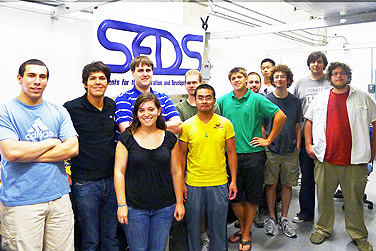News
Building satellite for space launch

UB’s student nano-satellite team, from left: Dan Kozlowski, Michael D’Angelo, Dan Pastuf, Lisa Alagna, Zachary Pace, Calvin Lau, Jonathan Gambacorta, Nick Sinno, Yang Li, Nathan Ohmit, Alex Wende and Mathew Bowers.
-
 Print
Print -
 Comments
Comments
-
“You have the opportunity to build something that might go into space. What’s cooler than that?”
Many of the lights in the night sky are not stars, but man-made satellites, and those satellites soon could be joined by one built by UB students.
A team of students from UB has been chosen to participate in the U.S. Air Force-sponsored University Nano-satellite Program. Groups from 12 schools have been selected to compete in this round of the nano-satellite program.
The University Nano-sat Program aims to help train tomorrow’s space professionals by offering students the goal of developing, over two years, a flight-ready spacecraft designed to complete a mission chosen by the students.
“The nano-sat program provides significantly more ‘return’ than the typical academic program, giving more real-world engineering challenges and resources,” says Dan Pastuf, the team’s chief engineer and a senior aerospace and mechanical engineering major.
“Plus, you have the opportunity to build something that might go into space. What’s cooler than that?”
UB’s nano-sat team will receive a $150,000 grant from the Air Force Research Laboratory to develop and build its satellite, money that will pay for flight computers, optical and altitude sensors, and other components.
“The $150,000 budget is actually not that much for building a satellite, especially since modern satellite programs are on the order of hundreds of millions of dollars,” says Richard Linares, an aerospace engineering PhD student who’s serving as principal student investigator for the team.
“But our satellite is in the class of nano-sats, which means it’s smaller than your average satellite and therefore less expensive. Even with this size program, costs can still be much more than $150,000, and this is where the Air Force would like us to innovate by developing a spacecraft that is inexpensive but still very capable and cutting edge,” Linares says.
The nano-satellite will gather detailed light data of objects floating in space. This will help determine shape, orbit and material characteristics of objects.
The satellite also will attempt to observe “glints”—unique events in space—in which an object floating in space acts as a mirror, strongly reflecting the sun’s rays. Glints make the object in question significantly brighter, allowing the observation of details typically too dim to be seen.
Studying glints from a space-based platform, such as a satellite, means earth’s atmosphere no longer will be a factor when viewing objects in space.
While designing and building a satellite worthy of space travel may seem daunting, the student team receives guidance from John L. Crassidis, professor of mechanical and aerospace engineering, and former director of undergraduate aerospace studies.
Crassidis has worked on NASA satellites in the past, several of which currently orbit the Earth. With this experience, Crassidis is hopeful of the team’s chances for success.
“The students are eager and full of excitement, and I have full confidence that they will succeed,” he says.
Although construction of the satellite has just begun, the original team of eight students already has grown dramatically to more than 40. Students—regardless of academic background—are interested in sending something into space, team members say.
“Really, there’s a place for all interests and areas of expertise—from hard scientists like myself to financial gurus, to editors,” says Zach Pace, a sophomore physics and math major, and the team’s science and optics lead.
Pace anticipates the team will include more than 100 students before the January 2013 deadline.
The team will attend the American Institute of Aeronautics and Astronautics Student Satellite Flight Competition Review, where a panel will choose one group for the final phase of the program. The winning team’s satellite will be launched by the Air Force as an auxiliary payload into a low orbit.
“Even if our team is not selected as the winner, we still have a very good chance of flying,” says Michael D’Angelo, the team’s program manager and a senior electrical engineering and computer engineering major. “In previous competitions, the Air Force has funded second- and third-place contestants so they can fly.”
And if they win?
“If we do succeed, I will consider it a singular triumph for UB and the many students who will have labored on such a difficult endeavor,” says Pace.
To prepare for the project, four UB team members recently traveled to the University of Colorado-Boulder for the Student Hands-On Training workshop, Year 1 (SHOT1). The purpose of SHOT1 was to give the student teams competing in the Nano-sat program experience in the design and construction of satellite space hardware.
The students built a 1.6 pound satellite called a “balloon sat.” On the final day, the balloon sat was launched to an altitude of more than 18 miles and took several photos.

Reader Comments